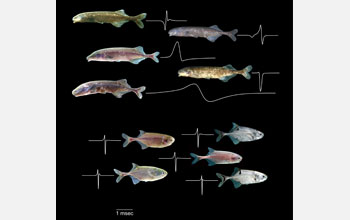Multimedia Gallery
Mechanisms of Signal Diversity in Communication (image 1)
All of the fish pictured here are in the family Mormyridae and can produce and sense electric fields. In the top group of fish (subfamily Mormyrinae), electric discharges have evolved quickly, resulting in dramatically different pulses of electricity among closely related species. In the bottom group of fish (subfamily Petrocephalinae), all of the species have similar pulses. The difference arises because the top group has the anatomical features needed to exploit the signal space, such as the anatomy needed to make different pulses and the sensory and analytical ability to perceive small differences in pulse shape.
These fish were the subject of research by Bruce Carlson, Ph.D., an assistant professor of biology at Washington University in St. Louis, Mo., who is studying this African family of weakly electric fish. Carlson found that different species in the mormyrid family communicate using different electric signals, which identifies the different species. When seeking a mate they can find partners of their own kind by listening for their preferred electric dialect. To learn more about this research, visit Carlson's website Here. This research was supported by a grant from the National Science Foundation (IOS 08-18390). [See also, Carlson B.A., Hasan S.M., Hollmann M., Miller D.B., Harmon L.J., Arnegard M.E. (2011) Brain evolution triggers increased diversification of electric fishes. Science 332:583-586.] (Date of Image: 2011) [See related image Here.]
Credit: Image by Bruce A. Carlson. Photographs by Sebastien Lavoue, Carl Hopkins, John Sullivan and Matthew Arnegard.
Images and other media in the National Science Foundation Multimedia Gallery are available for use in print and electronic material by NSF employees, members of the media, university staff, teachers and the general public. All media in the gallery are intended for personal, educational and nonprofit/non-commercial use only.
Images credited to the National Science Foundation, a federal agency, are in the public domain. The images were created by employees of the United States Government as part of their official duties or prepared by contractors as "works for hire" for NSF. You may freely use NSF-credited images and, at your discretion, credit NSF with a "Courtesy: National Science Foundation" notation.
Additional information about general usage can be found in Conditions.
Also Available:
Download the high-resolution JPG version of the image. (1.2 MB)
Use your mouse to right-click (Mac users may need to Ctrl-click) the link above and choose the option that will save the file or target to your computer.

